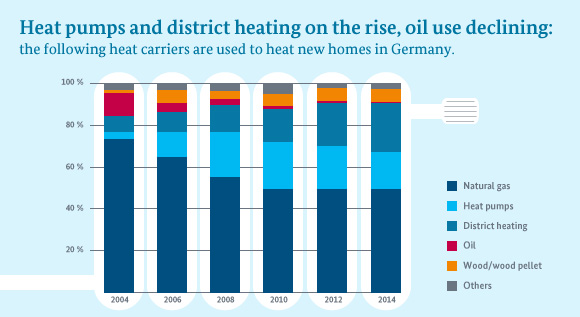This is how Germans heat their homes
As we can see from the heating systems installed in new homes, the heating market is currently experiencing a dynamic development. In the last few years, heat pumps and district heating systems have been used more and more. The latest statistics from the Working Group on Energy Balances confirm this trend.
 © Data: AGEB, graph: Federal Ministry for Economic Affairs and Energy
© Data: AGEB, graph: Federal Ministry for Economic Affairs and Energy
The majority of new heating systems installed in Germany use natural gas. Last year, a natural gas boiler was installed in almost one in two newly built homes (49.8%), and a heat pump in around one in five homes (19.9%). The percentage of new homes that use a district heating system is even a little higher (21.5 per cent); around 6 per cent of homes use wood and wood pellets as their primary source of heat. The share of oil-fired boilers installed in new homes has become negligible, reaching only 0.7 per cent in 2014. Ten years ago, the situation was completely different. In 2004, oil-fired boilers were still installed in one in ten new homes (10.7%). However, data on the housing stock shows that their market share has been declining sharply for some time now. Although gas-fired boilers are still used in 26.8 per cent of German homes, their share is down from 34 per cent twenty years ago. As very few oil-fired boilers are installed in new homes, the share of this type of heating system in the housing stock will continue to fall.
While fewer homes are equipped with an oil-fired boiler, the number of heat pumps used has grown fast over the recent past. A heat pump works by extracting heat from the air or the ground to heat your home. Basically, it works in the opposite way to a fridge. While heat pumps had a market share of 3 per cent back in 2004, their share in new homes alone increased to 19.8 per cent in 2008. The number of homes using district heating systems has almost tripled over the last decade (2004: 7.3%).
However, it will take some time for this development to really make a difference in the housing stock. There are 38.4 million homes in Germany. In 2014, building permits were issued for around 10,000 homes. When taking into account all existing homes, the share of district heating in 2014 amounted to 13.5 per cent, compared to 1.5 per cent for heat pumps – in spite of the boom experienced by this technology over the past few years. But the type of heating system used is not only changing in newly built homes, but also when homes are modernised. On average, heating boilers in Germany are 17.6 years old (see also: ‘New heating systems are more efficient and come with better labelling’).
Home owners benefit from funding for new types of heating systems
Changing the old boiler in your basement usually comes with a high price tag attached, so you are not very likely to do it every few years. However, a change might pay off sooner than you think, as your heating costs will go down. Since 1 August 2015, home owners have been offered even more support when changing to an energy-efficient heating system thanks to KfW’s improved 'Energy-efficient retrofitting' scheme. Under this programme, home owners can receive a grant of 10 per cent for investing in a modern, energy-efficient oil-fired or gas condensing boiler. Home owners switching over to renewables and planning to use solar thermal energy, a heat pump or a pellet heating system in their homes can claim additional funding under the Market Incentive Programme launched in April 2015: at least €2,000 for a solar thermal installation, at least €4,000 for a geothermal pump and at least €3,500 for a pellet boiler with a heat storage unit.

